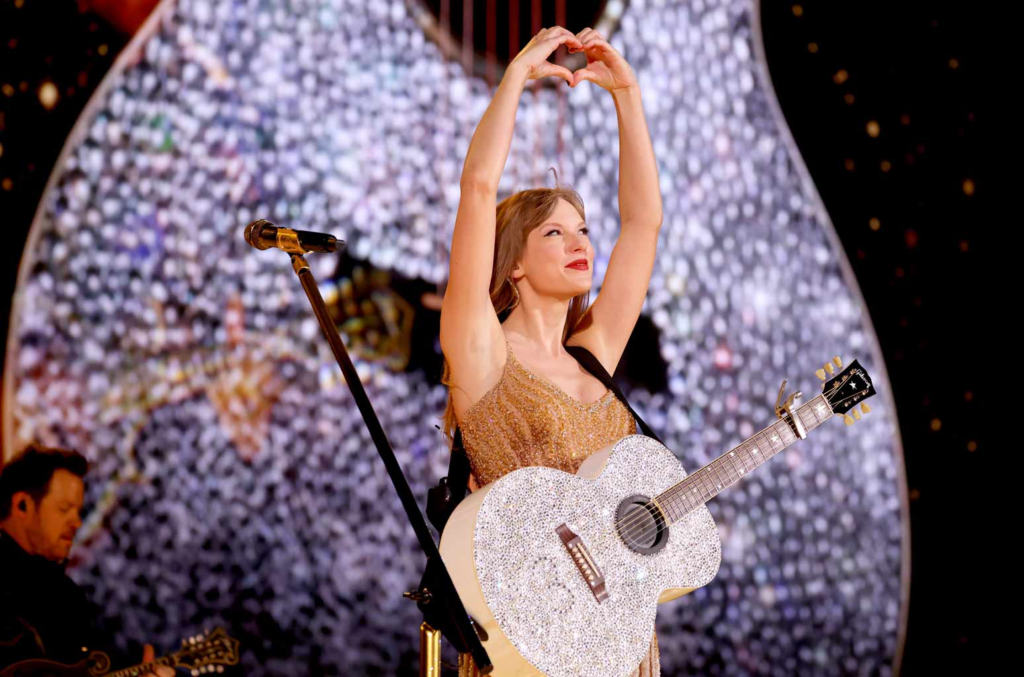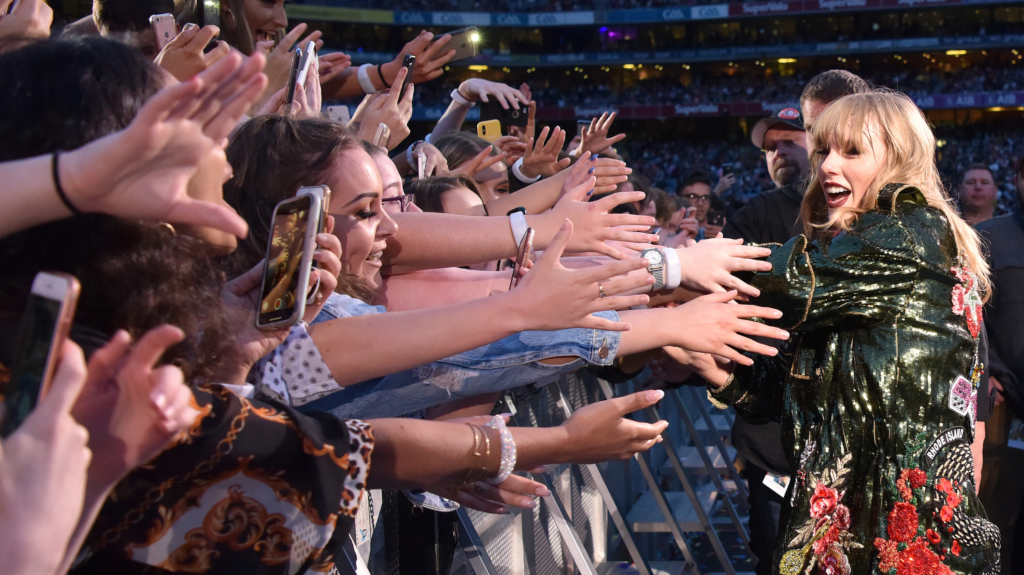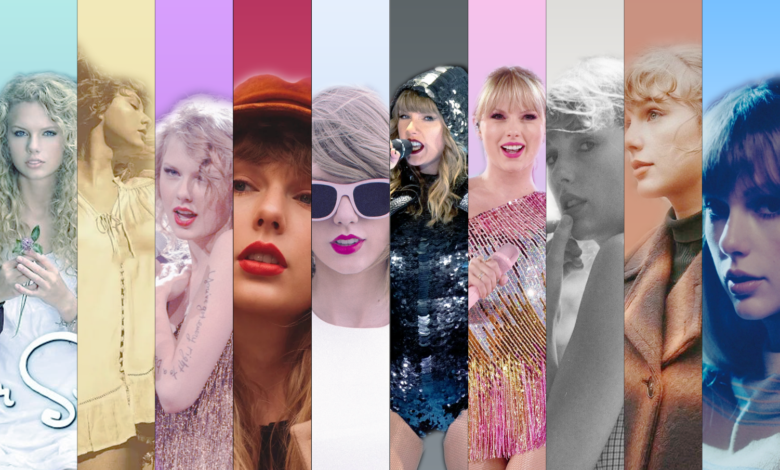The enthusiastic shout echoing through the concert venue was typical of what one might hear at live shows, originating from a fan seeking a fleeting connection with the artist on stage. However, on this particular Friday night, Taylor Swift, in her physical form, was notably absent. The fan directed their adoration towards a movie screen at a sold-out screening of Swift’s latest concert film, “Taylor Swift: The Eras Tour,” in downtown Manhattan.

This is the prevailing sentiment of being a devoted Taylor Swift fan in 2023: We believe that she communicates with us directly through our screens, and we feel that our messages to her are heard and acknowledged.
The Unprecedented Connection Between Taylor Swift and Her Fans
For a significant portion of Swift’s extensive fanbase who didn’t secure tickets through Ticketmaster or weren’t willing to break the bank for secondary market seats, the existence of this movie is either a small miracle or a consolation prize, depending on one’s perspective. (It’s worth noting that Swift has previously released concert films for most of her past tours, but they were not widely shown in theaters.) It provides a reasonable simulation of the live concert experience, offering two hours and 45 minutes of Taylor Swift immersion therapy at the affordable price of $19.89 per ticket (a playful nod to her birth year).

“The Eras Tour” is a straightforward concert documentary, filmed across multiple nights at SoFi Stadium in Los Angeles in August. It faithfully follows the live show’s setlist, with a few songs trimmed from the three-and-a-half-hour runtime, possibly to avoid overwhelming the audience (or with potential plans for a “Director’s Cut” in the future). Songs such as “The Archer,” “Long Live,” the Haim collaboration “No Body, No Crime,” the “Seven” interlude, “Cardigan,” and “Wildest Dreams” didn’t make the cut for the film.
Additionally, two memorable moments from the live show, including Swift’s heartfelt remarks after performing “Marjorie” in honor of her late grandmother and her preamble to “Betty” about appreciating men who apologize, were omitted.
I had the privilege of attending the Eras Tour live on two occasions. I experienced it from the nosebleeds after enduring a lengthy wait in the Ticketmaster online queue, and I was also fortunate to be near the stage thanks to a friend who had an extra ticket. These concerts were among the best I’ve ever attended, showcasing an artist at the peak of her abilities, spanning a 17-year journey from a country girl to global superstardom through breathtaking stage design, captivating visual effects, boundless energy, and an endless stream of hit songs.
The audience’s enthusiasm was so intense that it could almost be measured on the Richter scale. I left those stadiums in a euphoric state, my voice hoarse from singing along, my feet sore from dancing, and my arms adorned with friendship bracelets gifted by fellow fans.

Watching “The Eras Tour” film in a theater was an attempt to recapture that euphoria. Its release coincided with a time when the desire for Taylor Swift-induced escapism reached unprecedented levels. In the two months since the initial leg of the tour concluded, Swift had frequently dominated the news cycle, from announcing the imminent release of “1989 (Taylor’s Version)” to making public appearances with a football player, drawing Beyoncé to her premiere, and setting records for ticket sales. These distractions were a welcome relief from the tumultuous state of the world in 2023.
A Surreal Evening: The Scene Inside the Manhattan Theater
Outside the movie theater on that Friday evening, Manhattan was tense, dealing with a week of tragic events in Israel and Gaza and bracing for potential protests throughout the city. Inside the theater, groups of mostly white, predominantly female Swifties, dressed in folklore-themed cardigans and “We Are Never Ever Getting Back Together” T-shirts, posed for selfies with their Eras-branded popcorn buckets.
It was improbable that any of us in that theater had ever experienced close-range rocket fire. Switching off my phone after hours of incessantly following the news to immerse myself in the ethereal sounds of the opening track, “Miss Americana and the Heartbreak Prince,” was a striking form of cognitive dissonance, akin to a puzzling decision I made with my college boyfriend to watch the movie “Pootie Tang” on September 11.
However, we all employ different coping mechanisms. Over the past few years, marked by the pandemic, social unrest, environmental disasters, and societal upheaval, there have been numerous instances when the most uplifting part of my day was spent scrolling through Taylor Swift content on social media.
To me, Taylor Swift represents a beacon of escapism, as today’s youth might say. Nevertheless, even the most influential individuals can stumble or, at the very least, wear us down. I can empathize with the frustrations that come with the Taylor Swift news cycle: her association with Matty Healy, her private jet’s carbon emissions, allegations of performative allyship, and the rewriting of her own history.
That spontaneous outburst occurred during the standing ovation following “Cruel Summer,” the second song in the setlist. Until that moment, the atmosphere in the theater had been relatively subdued. But when Swift paused to survey her domain, teasing the crowd before “The Man,” something changed. By the time the song’s chorus kicked in, a small group of dancers had congregated in the space between the screen and the front row.
As the film progressed, the crowd steadily grew, and approximately half of the theater’s audience was on their feet by the time “Red” began. I tried my best to remain focused on my note-taking task for this article, but halfway through “All Too Well,” I couldn’t resist any longer, and I, too, joined in the dancing.

Certainly, a live concert offers numerous advantages over a film: the element of unpredictability (will there be a wardrobe malfunction or an unexpected incident?), the privilege of breathing the same air as Taylor Swift, and the luxury of experiencing the show without a screen as an intermediary. However, the magic of a movie should not be underestimated. The cameras provide angles and close-ups that even the most observant in the audience couldn’t capture, highlighting intricate movements and facial expressions
Read our more blogs on retailinsights


